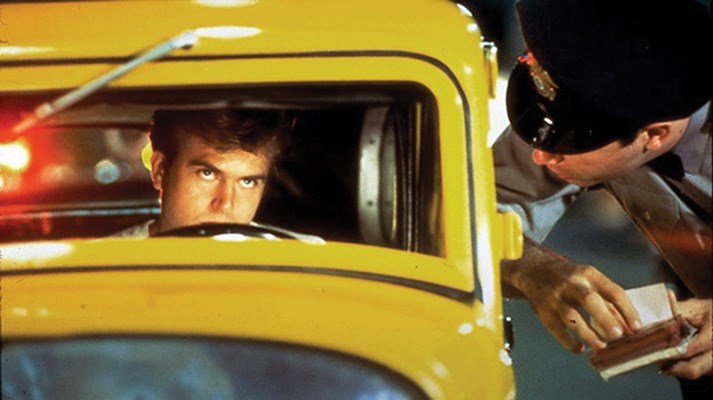FORTY years ago this month, the movie posters asked audiences, "Where were you in '62?" For most people, the answer was, "in a better place." The world in 1973 was not in great shape, and as far as cars go, was about to get a whole lot worse. The start of the gas crisis was not far away, and the motoring world would be plunged into a frenzy of fuel-saving measures that would result in the death of the muscle car and the production of some of the worst-performing machinery ever built.
Many baby boomers were wondering just what had happened to all the youthful hope and innocence of the 1950s and 1960s. They bought their movie tickets and, as they sat quietly munching popcorn in the darkness, tried to remember exactly what those days gone by were like. Where were they in '62? They thought back.
The scenes that unfolded before their eyes would be called, by Roger Ebert, one of the greatest pieces of historical fiction ever filmed. It was a slice of Americana, cruising around in hot rods, disc jockeys spinning early rock 'n' roll and crooners on the late-night AM radio. Burnouts and drag races, of chrome and drive-in diners; cheap gas and four wheels to freedom.
It's a film that almost didn't get made. Little-known director George Lucas had the backing of his friend, producer Francis Ford Coppola, but the studios passed, one after another. Finally, Universal studios picked it up and filming started on Lucas' semi-autobigraphical story of the South Californian hot rod culture of the '50s and '60s.
Some of the mostly unknown actors - Richard Dreyfuss, Harrison Ford, Ron Howard - would go on to become household names. Others would remain supporting cast throughout their careers. The real stars, though, were the cars.
The hero of the piece is one of the most famous machines ever to grace the silver screen, the bright-yellow '32 Ford five-window coupe driven by fictional street racing champion John Milner. Picked up in LA for $1,300 by one of American Graffiti's producers, the little deuce coupe was already chopped down and mildly souped up.
Unfortunately, it wasn't anywhere near ready for primetime and needed considerable work to get it from its primered, red-and-grey current state to the shiny yellow rocket that would be the "fastest in the valley." Besides the paintwork, the car needed a complete mechanical overhaul from manifolds to headers, as well as further cosmetics like a sectioned-down radiator grille and periodcorrect fenders. Soon, it stood ready to do battle.
The main rival for the '32 was Harrison Ford's (as the cowboy-hat-wearin' Bob Falfa) '55 Chevy. This all-black machine had a more-storied history than the Deuce, having been one of three similar cars used in filming an earlier roadtrip movie called Two-Lane Blacktop.
One of the three had already been claimed by the crusher, but both the 454-powered stunt car and the 427-engined star-car had both survived. Both these would be painted black and were then joined by a third machine rescued from a junkyard for the sole purpose of being blown up at the end of the movie.
The car with the 427 was the one driven by Harrison Ford and it's something fairly special. Besides the monstrous engine, the black Chevy had flared-out wheel wells to fit the massive tires, a roll-cage (which would later come in handy) and a hoodscoop set to clear the intake.
While the two combatants circle each other throughout the movie, we're shown vignettes of the other players. Dreyfuss' character, Curt Henderson, spends the film trying to track down an elusive blonde in a white 1955 Ford Thunderbird. This car is still in the hands of its original owners, and was only lent briefly to the film crew - it wasn't involved in any high-speed hijinks.
Ron Howard's character, the college-bound Steve Bolander, lent his '58 Impala to the nerdy Terry "Toad" Fields. By some miracle, the car worked its magic and the Toad (normally perched on a Vespa) found himself on the hottest date of his life.
Meanwhile, the background is filled with rumbling V-8s circling aimlessly, pulling in at Mel's drive-in or staging impromptu street races. A pack of Greasers with slicked-back hair hit the scene in a chopped-down Mercury lead-sled, eventually cajoling Henderson into helping them pull a prank on the cops.
In one of the better known scenes of the movie, a chain is surreptitiously hooked to the back axle of a parked Dodge Monaco cruiser. When the officers gun it out of the lot to chase down the speeding miscreants, the whole back end comes off the police car.
Not that you'd get away with that sort of behaviour today or even back then, but like I said, it's a fictionalized account.
Audiences lulled into happy nostalgia were perhaps shocked by the end credits. A title card showed that none of the male characters had what could traditionally be called a happy ending: one killed by a drunk driver, one MIA in Vietnam, one stuck in an implied dead-end job, and Henderson a writer in Canada, perhaps a draft dodger.
Critics at the time liked the movie, but thought its scenes of youthful simplicity and the undercurrent of coming change might not make sense to those who hadn't lived through it.
But whether you see American Graffiti as a snapshot of SoCal hot rod history or just a really good car flick, four decades later, it still stands the test of time.
Brendan McAleer is a freelance writer and automotive enthusiast. If you have a suggestion for a column, or would be interested in having your car club featured, please contact him at [email protected]. Follow Brendan on Twitter: @brendan_mcaleer.



